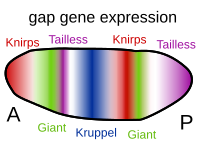
Photo from wikipedia
BackgroundThe gap gene system controls the early cascade of the segmentation pathway in Drosophila melanogaster as well as other insects. Owing to its tractability and key role in embryo patterning,… Click to show full abstract
BackgroundThe gap gene system controls the early cascade of the segmentation pathway in Drosophila melanogaster as well as other insects. Owing to its tractability and key role in embryo patterning, this system has been the focus for both computational modelers and experimentalists. The gap gene expression dynamics can be considered strictly as a one-dimensional process and modeled as a system of reaction-diffusion equations. While substantial progress has been made in modeling this phenomenon, there still remains a deficit of approaches to evaluate competing hypotheses. Most of the model development has happened in isolation and there has been little attempt to compare candidate models.ResultsThe Bayesian framework offers a means of doing formal model evaluation. Here, we demonstrate how this framework can be used to compare different models of gene expression. We focus on the Papatsenko-Levine formalism, which exploits a fractional occupancy based approach to incorporate activation of the gap genes by the maternal genes and cross-regulation by the gap genes themselves. The Bayesian approach provides insight about relationship between system parameters. In the regulatory pathway of segmentation, the parameters for number of binding sites and binding affinity have a negative correlation. The model selection analysis supports a stronger binding affinity for Bicoid compared to other regulatory edges, as shown by a larger posterior mean. The procedure doesn’t show support for activation of Kruppel by Bicoid.ConclusionsWe provide an efficient solver for the general representation of the Papatsenko-Levine model. We also demonstrate the utility of Bayes factor for evaluating candidate models for spatial pattering models. In addition, by using the parallel tempering sampler, the convergence of Markov chains can be remarkably improved and robust estimates of Bayes factors obtained.
Journal Title: BMC Bioinformatics
Year Published: 2019
Link to full text (if available)
Share on Social Media: Sign Up to like & get
recommendations!